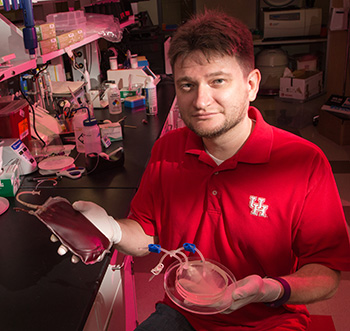
BLOOD DISORDERS

By Laurie Fickman
 Sergey Shevkoplyas |
With severe blood disorders such as leukemia, doctors often rely on leukapheresis, a procedure in which large machines extract whole blood from patients to separate white blood cells from the rest of the blood, which is then returned back to the patient. This procedure is generally used to urgently reduce a dangerously elevated white blood cell count, or to collect various white blood cell subsets for therapeutic purposes.
“Although well-tolerated by most adults and older children, leukapheresis in young children, weighing less than about 22 pounds, is technically challenging and clinically risky,” said biomedical engineering professor Sergey Shevkoplyas. He has been awarded $1.6 million from the National Heart, Lung, and Blood Institute to develop pediatric-sized technology. Baylor College of Medicine collaborators include Fong W. Lam and Karen R. Rabin.
Leukapheresis is currently performed using centrifugation-based machines, which require a substantial amount of blood be taken out of a patient, putting small children at significantly higher risk of low blood pressure, catheter-related thrombosis, infections, severe anemia and even death.
Shevkoplyas is developing a new device that looks like a small plastic dish with many tiny channels cut into it. The channels are designed to separate blood cells by size, using a new cell separation approach called controlled incremental filtration (CIF). He and his colleagues are planning to adapt CIF to enable separation of white blood cells from flowing blood with high efficiency, minimal loss of red blood cells and platelets, and at flow rates on par with conventional leukapheresis.
“The ability to perform leukapheresis safely and effectively in these most vulnerable pediatric patients will significantly increase their access to a rapidly expanding range of highly effective cell-based therapies, thus having a potentially transformative impact on health and well-being of children worldwide.”
“Since all the existing machines were built for adults, we have to do something very special for babies, that’s what is inspiring us,” Shevkoplyas said.
$1.6 MILLION RESEARCH FUNDED BY:
